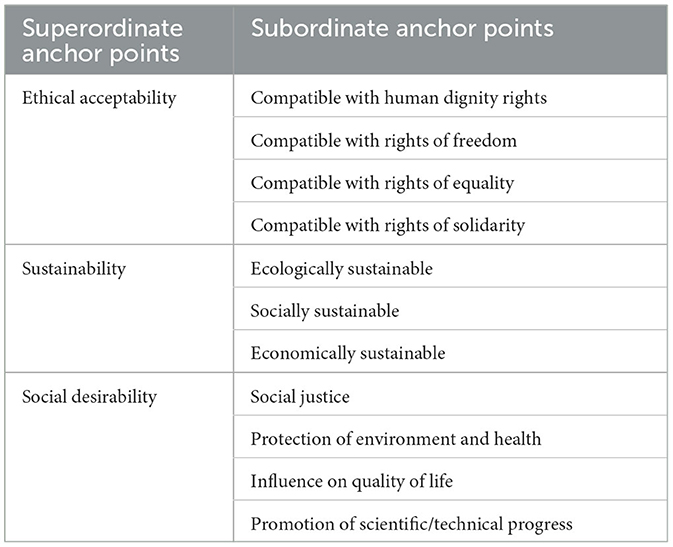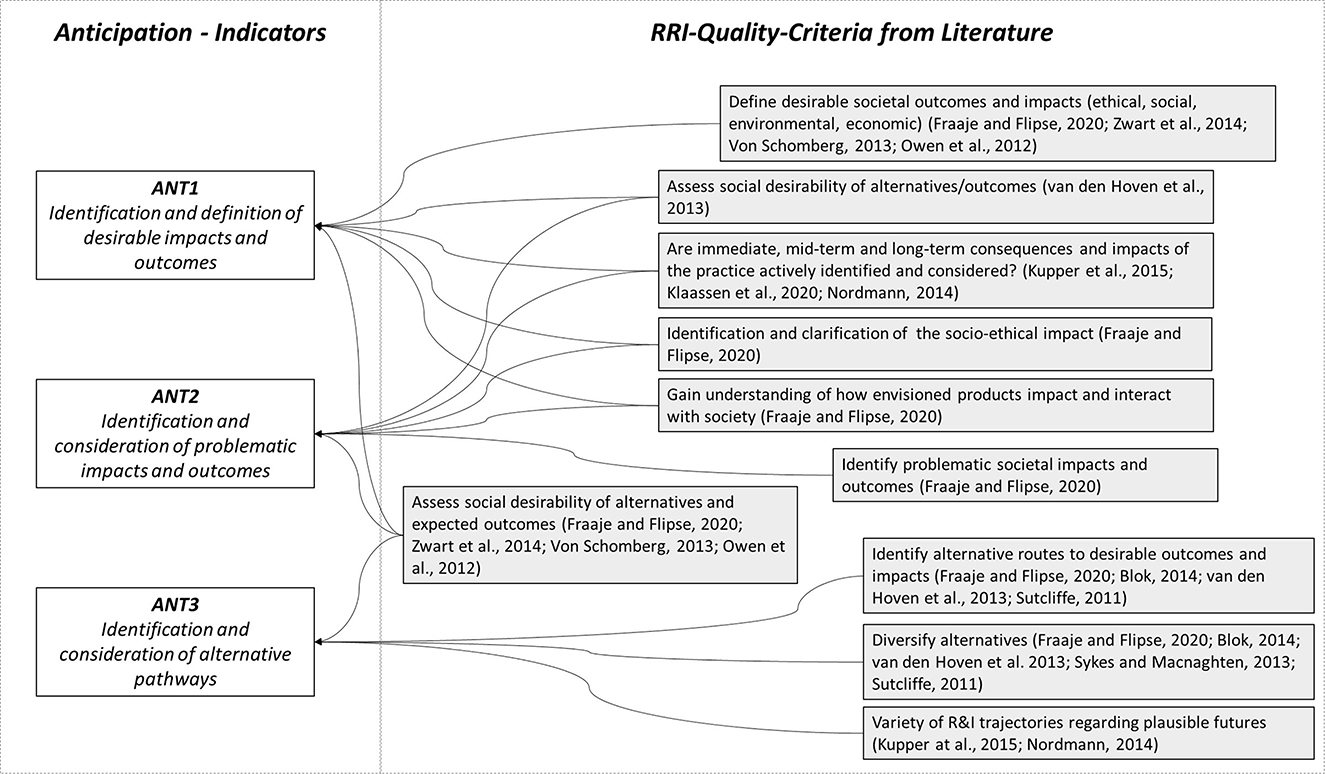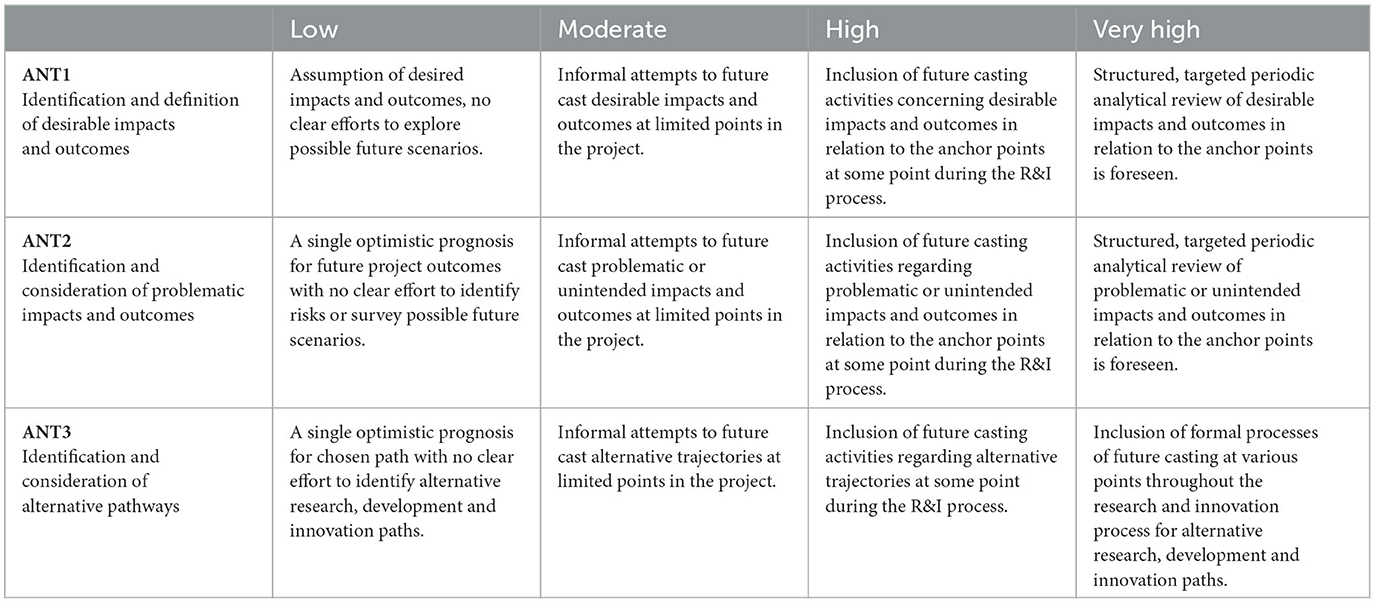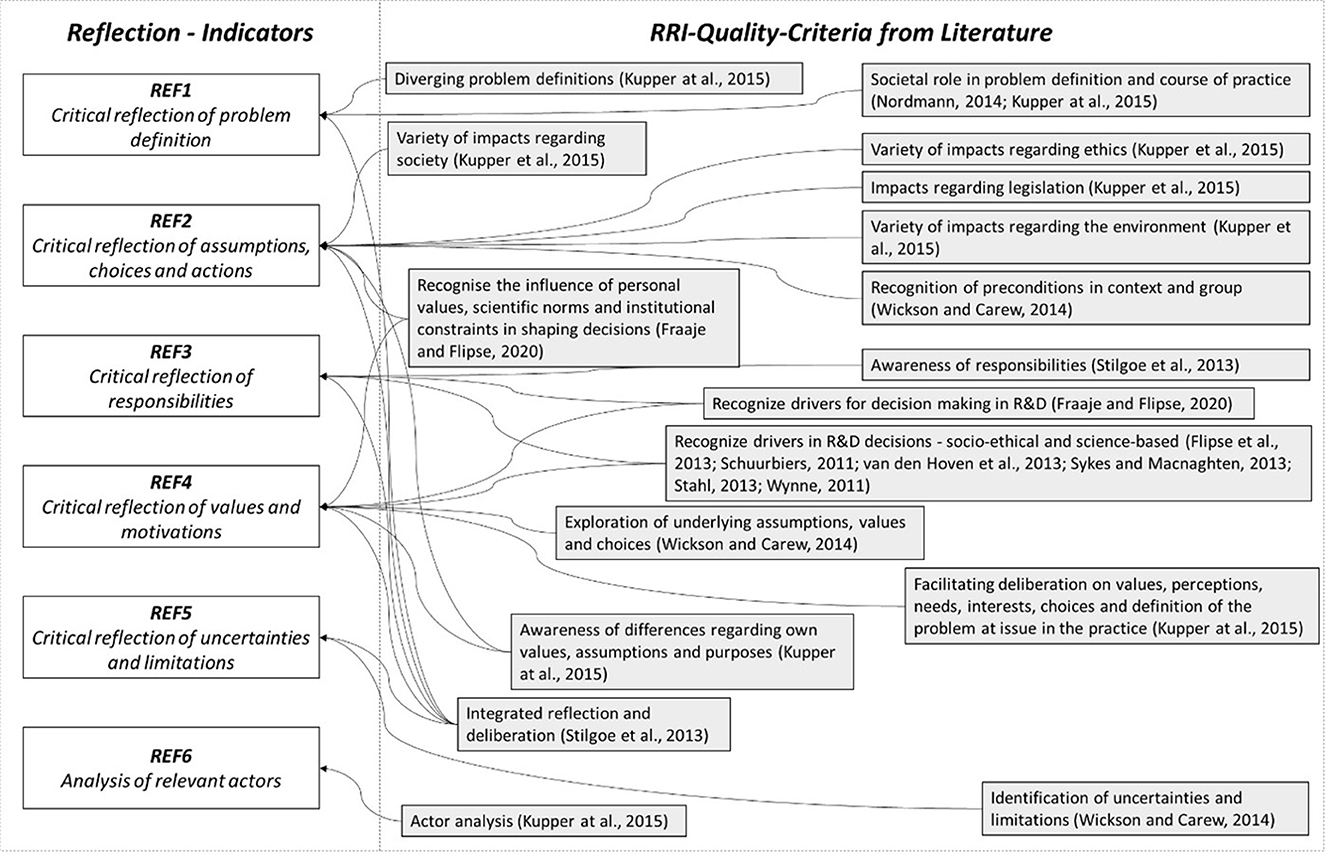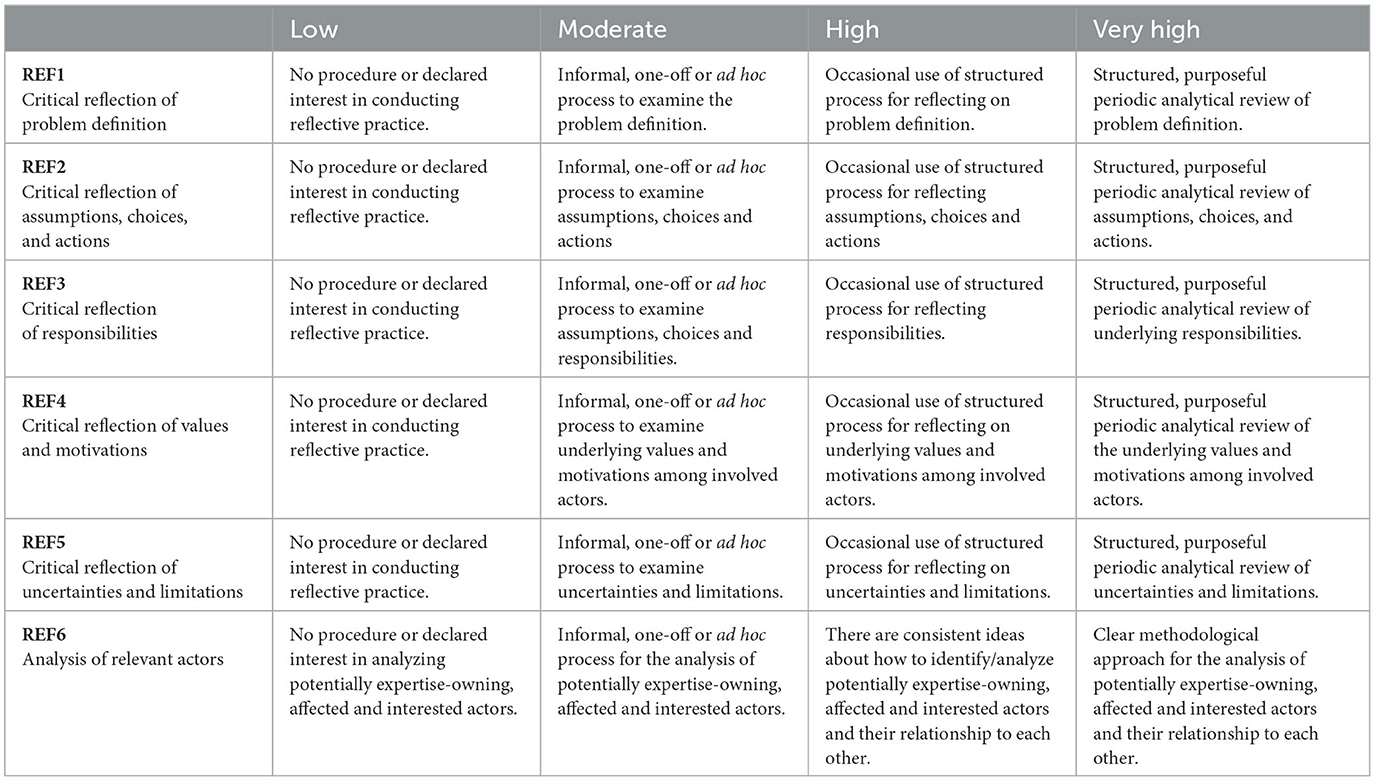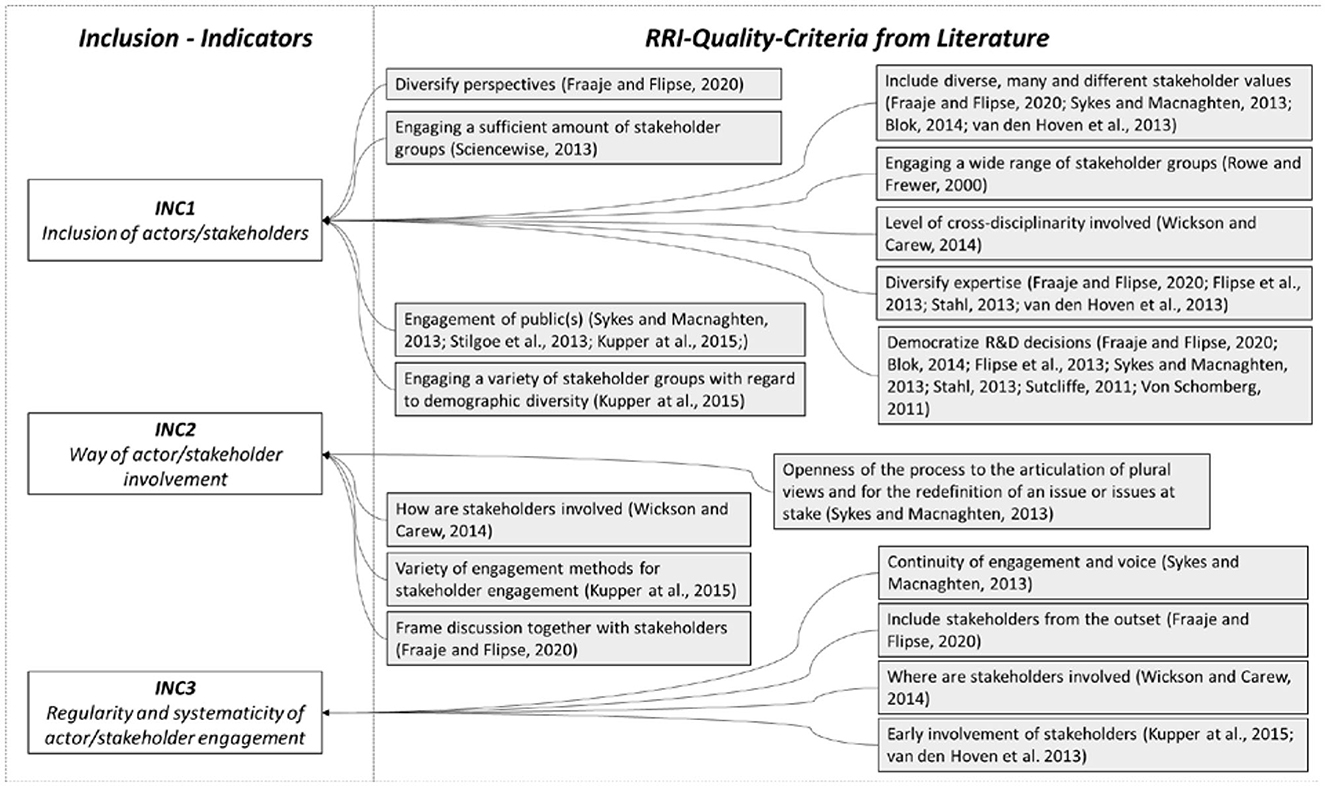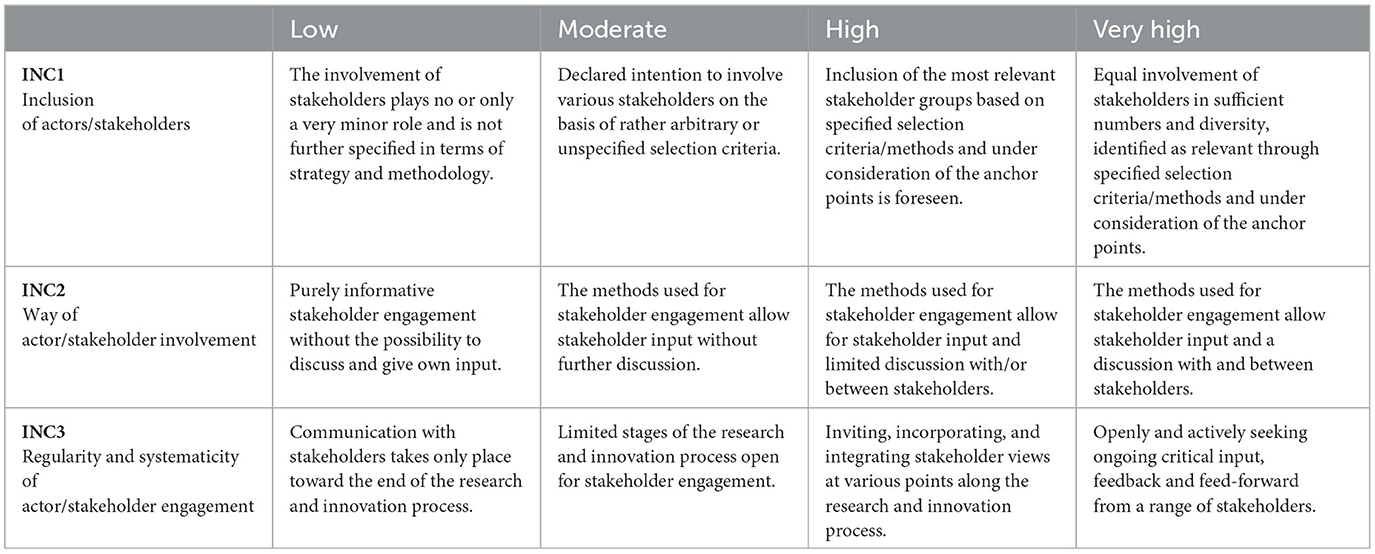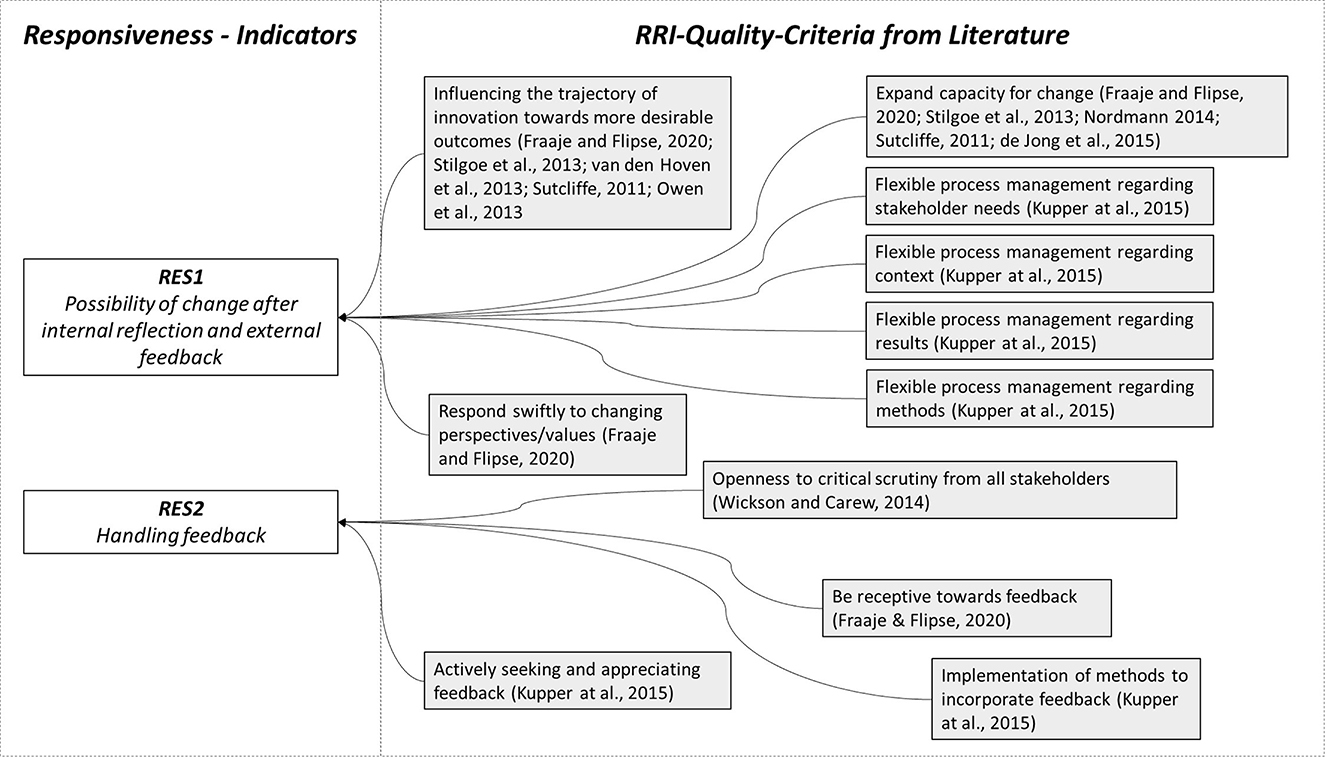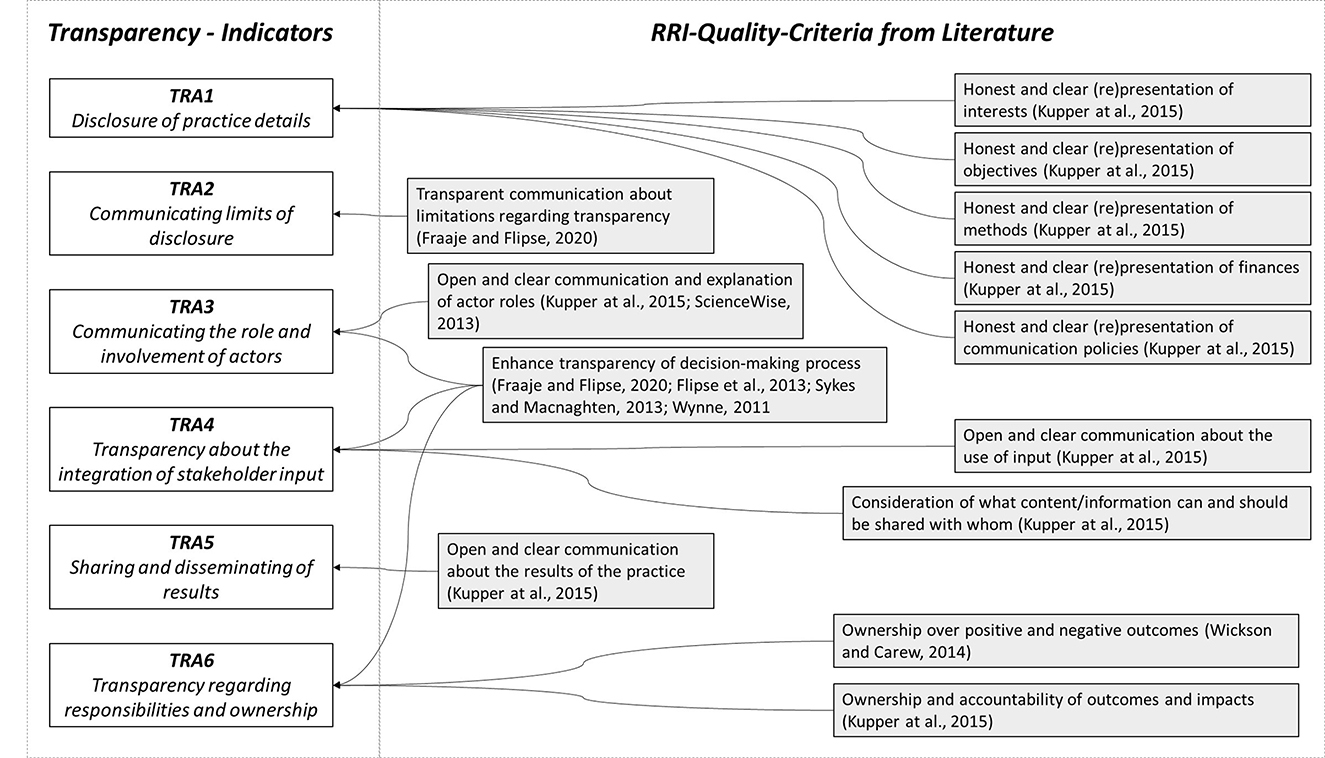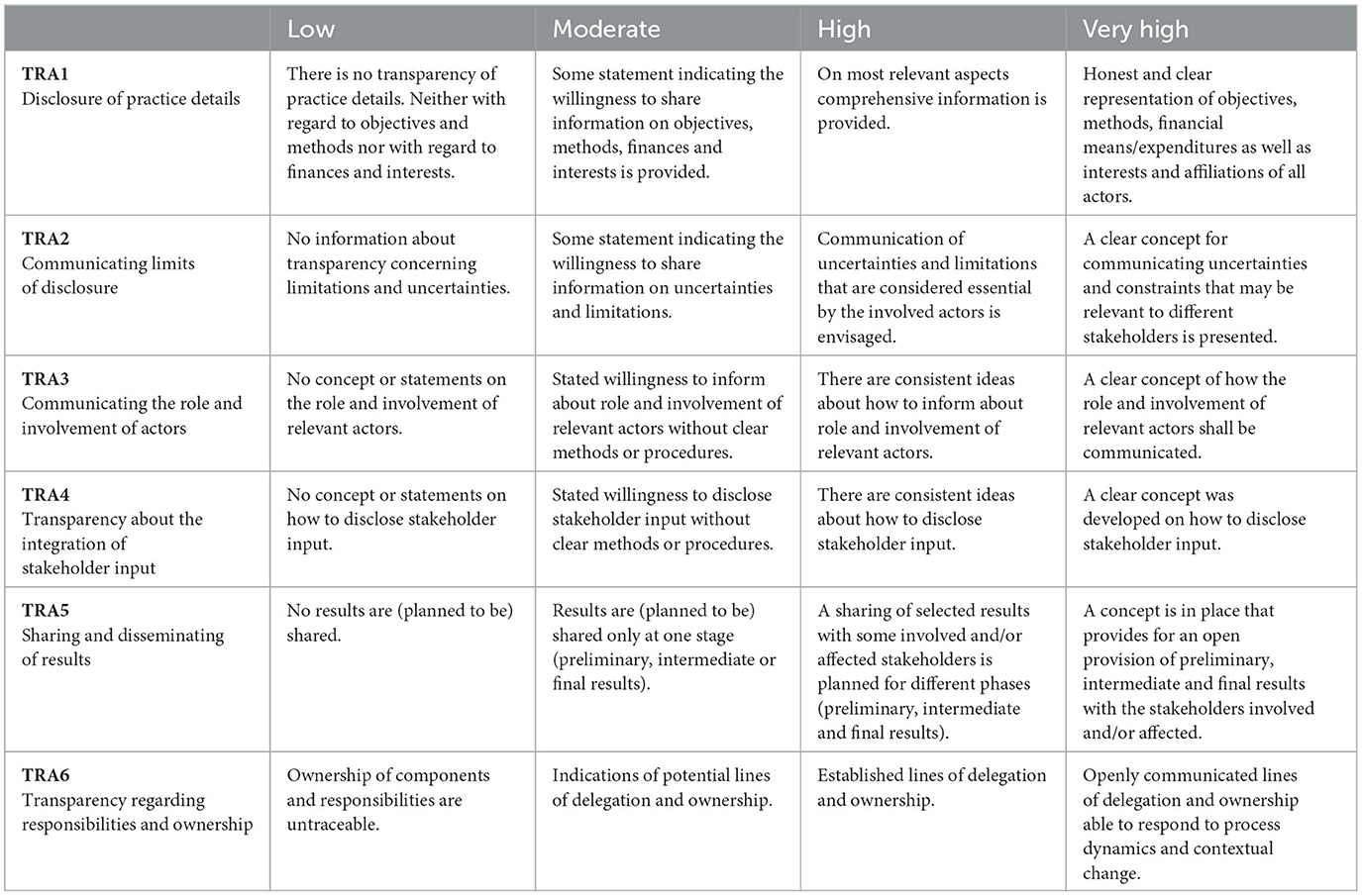- 1Department of System Analysis, Zentrum für Sonnenenergie- und Wasserstoff-Forschung Baden-Württemberg, Stuttgart, Baden-Württemberg, Germany
- 2Department of Innovation Economics (520i), University of Hohenheim, Stuttgart, Germany
- 3Department of Economics, University of Insubria, Varese, Italy
- 4Flying Faculty, Department of Economics, Turkish-German University, Istanbul, Türkiye
- 5DIALOGIK gemeinnuetzige Gesellschaft für Kommunikations- und Kooperationsforschung mbH, Stuttgart, Baden-Württemberg, Germany
Efforts to reduce global greenhouse gas emissions have had limited success. For many, the hopes rest on new energy innovations to advance the energy transition process. In this paper, we develop a Responsible Research and Innovation (RRI) base indicator system to steer the design of innovations in the field of energy transition innovations and, thus, improve social acceptance of these innovations. We propose a guideline for its application to assist R&D performing organizations and funding organizations in the design, selection, and communication of research proposals. The indicator system is intended to promote early integration of environmental and social aspects, support the formation of teams aware of the different responsibility aspects of innovation, and monitor progress in regard to relevant RRI dimensions.
1. Introduction
Political efforts have led to only limited reductions in global greenhouse gas emissions. Accordingly, many hopes rest on energy transition innovations that are effective, experience a high level of social acceptance and can thus be implemented widely in order to successfully advance the energy transition process. In our study,1 we refer by social acceptance to the passive or active socio-political and community acceptance of energy technologies, i.e., the public's passive or active approval (based on subjective valuation rather than scientific expertise) of decisions by others (Bertsch et al., 2016). A starting point of our considerations is the fact that passive or active social acceptance of energy transition innovations cannot be taken for granted, despite the general broad acceptance of the transition of the energy system. One reason for this is that potential negative impacts of innovations are often only recognized, regulated and mitigated, after the diffusion of the innovation and thus after they have negatively affected the acceptance of customers (Collingridge, 1980; see also Müller, 2016; Schlaile et al., 2018 for a discussion). As a result, research, technology development and innovation (RTI) processes are often not forward-looking, and there is a lack of early integration of environmental and social research.
Despite an ongoing debate about the normative aspects of innovations (see for example Schlaile et al., 2017) innovations are often considered as something inherently positive and a determining factor of economic growth and long-term prosperity. However, there is increasing recognition that innovations can have undesirable consequences, such as environmental destruction, impairment of human rights, negative employment effects, or undesirable distributional effects (Giuliani, 2018) that delimit their societal benefits and social acceptance. Innovation is hence neither inherently good nor self-regulatory. This is also recognized in most of the literature on Responsible Research and Innovation (RRI). As also (Koops, 2015, p. 2) puts it: “although ‘responsible innovation' is a term that is increasingly used both in academic and in policy circles, it is by no means clear what exactly the term refers to, nor how responsible innovation, once we know what is meant by this, can or should be approached.” In other words, while the central idea of RRI—to adapt innovations to societal wishes and needs—is relatively unchallenged in the innovation and policy research community, beyond existing methods such as technology assessment or foresight, many questions regarding the actual application of the RRI concept in a policy, research, and business context are unanswered.
Recently, research projects have delved more deeply into the question of how RRI can be applied as a toolkit to help policy makers, scientists, and businesses (e.g., see https://rri-tools.eu/or and https://www.v4innovate.de/). Guidelines and indicator systems are being developed and applied as an orientation for the development and diffusion of more (societally and environmentally) responsible technologies (e.g., Wickson and Carew, 2014; Meijer and van de Klippe, 2020). Traditionally, RRI has been applied to potential breakthrough (and/or general purpose) technologies such as biotechnology, genetic engineering, and quantum computing (Owen, 2019). However, there is a role for RRI not only for specific technologies but also for complex socio-technical transformation processes (including a wide range of different technologies) such as the transition of the energy system toward carbon neutrality (Owen et al., 2013).
In this paper, we set out a concept for an RRI indicator system that can help to cope with some of the key challenges arising when applying an RRI approach based on the example of technical innovations for the energy transition. We highlight three challenges, namely how to deal with the normativity of the RRI concept, how to handle subjectivity along the evaluation process and how to take the specificity of energy technology innovations into account. The foreseen users of the indicator system are R&D funding organizations (government research funding and funding from private foundations) and R&D performing organizations (public and private). The indicator system will help R&D funding organizations to: Find inspiration for funding anticipatory research on newly emerging energy transition technologies; Identify RRI-relevant research needs and research gaps in regard to already existing energy transition technologies and set up corresponding research funding programs (e.g., with the help of expert groups and/or multi-stakeholder agenda-setting processes informed by the indicator system); Inform the selection of research proposals for funding and take well-grounded funding decisions; Help communicate decision-making on proposal selection in a transparent manner.
The remainder of this paper is structured as follows: In Section 2, we present the conceptual background of the RRI indicator system. Section 3 describes the development of RRI process and product indicators. In Section 4, we delineate some concluding remarks.
2. Conceptual background
2.1. The need for RRI
The perception of the RRI concept varies widely in the literature. For example, some authors see RRI as a current concept (de Jong et al., 2015), others as an approach (Blok and Lemmens, 2015), ideal or desire (Owen et al., 2013), or process (Stilgoe et al., 2013; von Schomberg, 2013). Still others see RRI only as hype (de Jong et al., 2015) or even as a (failed) experiment (Delvenne, 2017). One central reason for this is the problem of how to actually apply the RRI concept. RRI builds on various precursor concepts that date back to the middle of the last century, both at the level of research funding policy and at the scientific level. In this regard, various streams within Science, Technology, and Society Studies (STS) are often cited in the literature as the origin of RRI (van Oudheusden, 2014; Koops, 2015; Carbajo and Cabeza, 2018; Brundage, 2019). Arguably, RRI has the most common ground and overlap, especially in scholarly discourse, with the concept of technology assessment (TA; see, for example, Grunwald, 2014; van Oudheusden, 2014; van Lente et al., 2017; Matthews et al., 2019) and the differences and similarities between these two concepts remain the subject of ongoing discussions.
Generally speaking, RRI processes involve activities that go beyond a mere compliance with legal rules. They refer to sub-legal responsibilities and aim at voluntarism, self-commitment and compliance with sub-legal rules such as administrative provisions (e.g., funding regulations). In fact, the legal framework conditions must be complied with anyway, e.g., minimum distances when operating wind turbines. However, it can also be the case that laws (abroad) are generally felt to be too weak, e.g., in the field of cobalt extraction in Congo and the resulting problems with the acceptance of batteries (see for example Arnaldi and Gorgoni, 2016). Another important reason for the need of RRI is that regulation (and standardization) tends to lag behind the development of innovations. Thus, RRI is especially valuable when new technologies are not yet regulated or when technology development is still ongoing. Its application can contribute to realizing a more transparent research and innovation process, to increasing accountability and creating trust.
As emphasized by several authors, the aim of an RRI-informed research and innovation process consists of “shaping innovation” instead of “shaping technology” only (see for example Grunwald, 2011; van Lente et al., 2017). In our study, we relate RRI to the development of innovations (e.g., a new energy storage) and the further development of existing innovations (e.g., new types of batteries) for the energy transition. We have a similar broad understanding of the notion of innovative products as Van de Poel et al. (2017) to whom a product is “any kind of output that can be used by another actor for another end.” Moreover, the innovation needs to be the outcome of a deliberate knowledge generation process, which is typically an R&D activity. A central challenge here is that innovation processes are characterized by a high degree of uncertainty regarding their outcome, so-called “true uncertainty” (Knight, 1921) and a partly, non-linear and non-deterministic outcome. At the same time, it is clear that innovation is not a totally arbitrary process (like “manna from heaven”). Accordingly, the possibilities of early and exact planning and assessment of technology impacts are limited, yet, we firmly believe that it is possible to design systems and processes in such a way as to increase the probability that an innovation process and its outcome will be socially desirable and accepted.
In similar vein, we have to acknowledge that innovation and the diffusion of innovation are not steps isolated from society. Rather, these steps take place in a systemic context and in interaction with societal actors and ideas. The energy transition generally, and this includes the development and use of energy technologies, is a transformation process involving society as a whole (Schneidewind, 2018) and which is characterized by a high degree of complexity, uncertainty and ambiguity. Following the idea of Owen et al. who state: “The aim of RRI policy is that research and innovation should have a societally beneficial impact” (Fitjar et al., 2019, p. 773), we aim to operationalize RRI in form of a tool for directing the energy transition into societally beneficial directions. However, we abandon the idea that there is such a thing as an optimal solution to the energy transition or societal challenges in general and enhance the likelihood that energy transition technologies contribute to addressing other grand social challenges (e.g., loss of biodiversity; Schlaile et al., 2017).
2.2. RRI as a tool
Soon after the introduction of the RRI concept in the context of the European research agenda, discussions began on how the concept, which was initially discussed mainly theoretically, could be used in practice and for this purpose operationalized and possibly even made measurable (Monsonís-Payá et al., 2017). In this regard, Wickson and Carew (2014) argue that the formulation of both quality criteria and tangible RRI indicators in particular is an essential necessity if RRI approaches are practically applied in science, science funding, by innovation drivers and further stakeholders in the research and innovation system. The need for instruments to implement the RRI concept was also seen by the European Commission and led to projects to create indicators with a focus on monitoring RRI (European Commission, 2015; European Commission et al., 2018).
Despite these initial efforts and the increasing recognition of the necessity of RRI operationalization in the scientific community, corresponding (further) developments initially remained sporadic. Iatridis and Schroeder (2016) stated the development of tools and metrics in the RRI context was still in the development phase. Recent publications with reference to the practical use of RRI indicate an increasing interest in this field of tools-oriented research (see e.g., Yaghmaei et al., 2019; Kwee et al., 2021). The volume by van de Poel (2020), for example, provides an overview of recent efforts to further developing indicators for the operationalization of the RRI concept. Today, there exist various indicator sets that vary significantly from one another in terms of their characteristics, goals, addressed RRI dimensions and/or types of assessment. As also van de Poel's (2020, p. 350) states “one might wonder how what is supposedly one concept can lead to such diverse constructs.”
When scanning the relevant literature, we found indeed that existing sets of indicators mostly stand for themselves and miss reference points between each other. While this can be explained at least partly by different objectives, it is also apparent when comparing indicators sets that have similarly oriented assessment approaches. To create a common basis for RRI indicators, (Wickson and Carew, 2014, p. 261) develop a set of RRI quality criteria covering aspects which “'good' science and ‘responsible' research and innovation should entail.” They further suggest that the criteria and their proposed measurement should be adapted to the respective project or evaluation task. Extended and further developed representations of these quality criteria were developed within the framework of the RRI Tools project (Kupper et al., 2015) and the implementation framework of Fraaije and Flipse (2020). These criteria aimed at providing a comprehensive overview of “characteristics of research and innovation practices that should be targeted in assessment, monitoring or (self-)evaluation tools” (Kupper et al., 2015, p. 17) and were specifically designed as an assistance to operationalization. So far, however, the corresponding quality criteria have hardly been used to create actual indicator systems.
There are a number of concept-immanent challenges when operationalizing RRI (see also the discussion by van de Poel, 2020). First, we have to acknowledge that RRI is a deeply normative concept. This normativity concerns not only the question what a responsible innovation or responsible research might be, but also what RRI is and can or should do (see also Doezema et al., 2019; Wittrock et al., 2021; Völker et al., 2023). As also van de Poel (2020, p. 351) states, RRI “expresses what is desirable, not what is factually the case.” This means that in the attempt to measure RRI, “at least some of the attributes need to be normative or involve normative judgments” (van de Poel, 2020, p. 351). At the same time, we see that there is no common agreement or understanding of what RRI is or should be. This links to the general problem of subjectivity when operationalizing RRI through indicators, both from the perspective of evaluators but also from the perspective of those being evaluated. Consequently, we think that it is problematic to use indicators to judge between good or bad RRI but rather to guide better design of innovations. Second, and closely connected to the problem of normativity and subjectivity there is the general problem of how to measure RRI or RRI processes. This problem is particularly elevated by the fact that RRI can be seen as a “complex matter that can be related to diverse contexts, subject areas, and actors” (Tassone et al., 2018, p. 346). This ultimately leads to the point that a corresponding indicator approach requires rather qualitative indicators, which, nevertheless, is associated with an increased subjectivity in the assessment and thus an increased reliability problem. Some indicator sets try to mitigate this problem by reverting to a binary measurement without the possibility to apply a more granular differentiation. Although this can indeed increase reliability by limiting the measurement options, it seems questionable whether such an approach can be justified regarding the complexity of the RRI concept. Finally, especially when applying RRI not only for single technologies but for complex socio-technical transformation processes (including a wide range of different technologies), the problem of specificity arises. Given the inherent normativity and subjectivity as well as the problems when measuring RRI, one may be tempted to apply generic indicators. Thereby, however, one risks to dilute the operationalization of RRI by using unprecise and unspecific indicators and by neglecting the specific and unique context of different technologies. In fact, it is highly likely that what can be considered an adequate concept for an indicator system will differ considerably across technologies but also for one single technology over time.
3. Indicator system conception
3.1. General structure of the indicator system
In the context of RRI, the literature differentiates broadly between two different perspectives. First, from a “product perspective,” RRI addresses directly the marketable products resulting from an innovation process through normative anchor points. Following the definition by von Schomberg (2013), these normative anchor points are (ethical) acceptability, sustainability and societal desirability. The product can be both a physical product and a non-physical product (e.g., in the sense of a service; Owen et al., 2013). Second, at a “process level,” RRI aims at a “more responsive, adaptive and integrated management of the innovation process” (von Schomberg, 2013). The process perspective can be subdivided into different process dimensions. Stilgoe et al. (2013) differentiate here between the dimensions of inclusion, reflexivity, anticipation and responsiveness. Based on an extensive review of the existing RRI literature, Fraaije and Flipse (2020) add transparency as a fifth dimension, as it has relatively broad support in the literature and shares various connections with the other dimensions. This subdivision into five dimensions is also taken up for the indicator system presented in this paper.
Although the distinction between product and process level was introduced early in the RRI literature, the focus mostly lies on the process level (Thorstensen and Forsberg, 2016). As also (Burget et al., 2017, p. 8) note: “researchers have seen RRI primarily as a process including stakeholders, anticipating, reflecting and responding to the needs and values of society.” (Wickson and Carew, 2014, p. 260) state in this regard that “any product developed through an innovation process will inevitably enter a complex web of interactions of use, the outcomes of which will be inherently uncertain” and that it would therefore make more sense to focus on the process side in the context of developing evaluation criterion for RRI. This is also underlined by Burget et al. (2017, p. 14), who conclude that “what the notion of RRI seems to point to is not to focus so much on bringing about certain outcomes as paying attention to the processual elements required for the implementation of a process.” However, this does not mean that the product perspective is to be completely neglected, but rather indicates that it is especially difficult to consider this level separately. In fact, the literature increasingly points out that a clear and sharp separation of the product and process side is hardly possible (Wickson and Carew, 2014; Thorstensen and Forsberg, 2016). This is highlighted by Wickson and Carew (2014, p. 260) also with regard to operationalization of RRI. They stress that in the context of an “[...] evaluation of a process of innovation, one still needs the capacity to also consider existing preconditions, envisaged products and engaged people, since all of these elements shape, guide and, to some extent, generate, and characterize the RRI processes [...].”
Consequently, the RRI indicator system presented here is focused on the process level while explicitly including the product level on the basis of so-called normative anchor points specified by von Schomberg (2013). These anchor points were also deliberately implemented because they reflect the “Grand Challenges” of our time (von Schomberg, 2013) and thus, are aspects that are essential to consider in context of energy transition.
3.2. Product perspective
According to von Schomberg (2013), the RRI product dimension captures products in relation to overarching and specific normative anchor points. In this regard, von Schomberg (2013) distinguishes three overarching indicator groups that need to be considered: Ethical acceptability, sustainability and social desirability. We draw on these central anchor points, also because they are reflected in the product-level subdivisions of most existing publications (see e.g., European Commission, 2015; Stahl et al., 2017; Fraaije and Flipse, 2020). Ethical acceptability of RRI products is reflected especially with regard to the fundamental values of the EU Charter of Fundamental Rights (von Schomberg, 2013). The essential personal freedoms and rights described in the Charter can be divided into six sub-areas: Dignity, Freedoms, Equality, Solidarity, Citizen's rights and Justice. Following this subdivision, research and innovation should strive for products that comply with the values of human dignity, which is expressed, among other things, in the integrity of the person and the exclusion of forced labor (especially in product production or service provision). In addition, the values of freedom have to be respected, which refers in particular to respect for private life, the right to freedom and security, and the protection of personal data. According to the principle of equality, general non-discrimination, respect for cultural, religious and linguistic diversity and equality between men and women are essential rights. The values of solidarity encompass numerous aspects, of which the prevalence of fair and equitable working conditions and the observance of youth labor protection are particularly relevant to the product dimension.
von Schomberg (2013) suggests sustainability as the second overarching normative anchor point of RRI which requires research and innovation to strive for the product's alignment with the EU's objective of sustainable development. This objective is subject to a 3-fold division of sustainability, analogous to the definition of sustainable development by the United Nations: economic sustainability, social sustainability, and environmental sustainability. Building on these three pillars, sustainable development aims at the capacity for “meeting the needs of the present whilst ensuring future generations can meet their own needs” (European Commission, 2014). Environmental sustainability is concerned with the extent to which the technology to be developed allows or hinders the considerate use of natural resources. Social sustainability focuses primarily on social issues, such as whether the development will lead to irreversible changes that future generations might not want. Finally, economic sustainability emphasizes that the way of doing business must not damage the required resources in the long term, so that they are also available in at least the same quality in the long term.
The third overarching normative anchor point is social desirability, which can essentially be represented by the normative anchor points of the Treaty on the EU. Some of the relevant aspects here can already be found in the fields of ethical acceptability and sustainability. Social desirability emphasizes that responsible technology development should not only be about developing technologies with low physical risk for people and the environment. In addition, a broad and inclusive deliberative process should be used to discuss which innovations would or would not be desirable for other reasons in solving major societal problems (in our case clean and safe energy plus climate protection). Such reasons can be, for example, the degree of social inclusion or the degree of fair benefit/burden sharing that can be achieved with a technology (Sarewitz and Nelson, 2008).
The superordinate anchor points ethical acceptability, sustainability and social desirability are subdivided into subordinate anchor points (Table 1). The product-oriented anchor points are integrated into the process dimension. This builds on von Schomberg's (2013) RRI concept according to which products should be designed with regard to their normative anchor points and thus the anchor points should by definition already be considered and included in the R&D process.
3.3. Process level
The design of indicators addressing the process level is based on the dimensions of inclusion, reflexivity, anticipation and responsiveness formulated by Stilgoe et al. (2013), as well as the fifth dimension of transparency proposed by Fraaije and Flipse (2020). In addition to these general process dimensions, various quality criteria are formulated in the literature (Wickson and Carew, 2014; Kupper et al., 2015; Fraaije and Flipse, 2020), on the basis of which a further subdivision of the process dimensions becomes possible. These quality criteria represent essential characteristics of research and innovation practices that should be considered in monitoring, assessment, or (self-) evaluation tools in the RRI context (Kupper et al., 2015). For this reason, we use these quality criteria as a basis for developing and formulating the process indicators assigned to the various dimensions. Based on a review of literature, we first collected existing RRI quality criteria. Here, in particular, the extensive work of Wickson and Carew (2014), Kupper et al. (2015), and Fraaije and Flipse (2020) already provides a large number of more than 100 criteria. In a second step, the full list of criteria was reviewed and bundled to serve as indicators in order to reduce the multitude of quality criteria to a manageable number. The associated (re)arranging, (re)interpreting, and/or applying of existing quality criteria is also explicitly desired in the context of RRI operationalization (Wickson and Carew, 2014). In this way, indicators can be derived from the RRI dimensions that cannot be measured directly, which make the respective RRI dimension measurable as a proxy (van de Poel, 2020).
While the challenges of operationalizing RRI as discussed above cannot be completely prevented, they can at least be reduced through an assessment process that is guided and that follows an assessment framework that includes a clear rubric, which guides the evaluator through the evaluation process by verbalizing the different indicator levels. A rubric, as for example shown in Wickson and Carew (2014), can reduce the subjectivity of assessments in this context (van de Poel, 2020) and at the same time is an appropriate way of evaluating the quality of RRI and the associated progress by clarifying explanations and providing “inspiration, concrete guidelines, and direction for improvement” (Wickson and Carew, 2014, p. 263).
The rubric for the indicator system presented in this paper is based on a four-scale classification, which reflects the degree of (methodological) consideration of the individual indicator fields and is thus intended to reveal opportunities for improvement. The bottom scale classification “low” therefore shows that the corresponding RRI aspect is not or only slightly pronounced, while “very high” indicates that the aspect is expressed very well. While the various RRI dimensions should be considered for each technology or use case, the optimal level can vary. van de Poel's (2020, p. 351) illustrates this with the example of the inclusion dimension, stating that “the ‘right” level of stakeholder involvement may not be the same for every innovation, or for each technical domain.” Especially for the field of energy system transformation, which in its breadth encompasses numerous different technical domains and innovations, such differences cannot be avoided. In view of this problem and the chosen level of observation, the indicators are not designed to represent a fixed level of responsibility for the individual dimensions. Instead, greater emphasis is placed on examining whether appropriate methodological approaches are integrated into or planned for the innovation process that allow for a specific process-internal assessment and integration of the RRI aspects.
The following sections deal with the individual process dimensions included in the indicator system and show the indicators formulated based on the quality criteria cited in the literature and the characteristics developed for them.
3.3.1. Anticipation
Anticipation describes the systematic attempt to investigate and assess as best as possible the (intended or unintended) consequences of innovations as early as possible. A related question that probably best describes this dimension is the question “what if?” (Owen et al., 2013). It is important to note that anticipation does not make predictions, but can highlight possible alternative paths that might be overlooked without a targeted and systematic anticipatory approach. As such, anticipation serves a purposeful reflection on the meaning, purpose and possible impact of an innovation and the systematic comparison of alternative options (Owen et al., 2013). The methods used range from foresight, technology assessment, horizon scanning, scenario analysis, and vision assessment to science fiction. The optimal timing for the use of these tools is in tension with the Collingridge Dilemma (Collingridge, 1980). They need to be applied early enough to have an impact and at the same time late enough to be useful. The result of a successful anticipation process is a sound understanding of the dynamics and forces that determine future technologies (Borup et al., 2006; Stilgoe et al., 2013; Burget et al., 2017). Additionally, anticipation can directly support the realization of responsible products since products become more ethically acceptable by becoming more “resilient” (Stilgoe et al., 2013) and also “socially robust” (Van den Hoven et al., 2013).
The quality criteria identified in the literature, shown in Figure 1, can essentially be divided into three groups, which are also found in the qualifiers presented by Fraaije and Flipse (2020). Indicator ANT1 aims at the extent to which an identification and definition of the desirable impacts and outcomes is planned within the research process (Owen et al., 2012; von Schomberg, 2013; Zwart et al., 2014). Indicator ANT2 points at the opposite case with the verification of the implementation of an identification and consideration of problematic impacts and outcomes. A corresponding need to consider both aspects also results from the statement by Owen et al. (2012), according to which responsible innovation should consider both intended and unintended aspects of science and innovation. This dual consideration is often bundled in formulated quality criteria by generally asking for consideration of possible consequences or desirability. In this way, it should be considered whether there is generally a systematic attempt to identify and consider potential immediate to long-term effects (Nordmann, 2014; Klaassen et al., 2017). The focus of consideration is partly on the societal level with the socio-ethical impact (Fraaije and Flipse, 2020), the social desirability of the outcome (Van den Hoven et al., 2013) and the impact and interaction of the product with society (Fraaije and Flipse, 2020). However, other criteria with the identification of intended and unintended, long-term economic, environmental and social consequences and impacts of the practice (Nordmann, 2014; Kupper et al., 2015; Klaassen et al., 2017) call for a broader spectrum of consideration, which is also reflected in the anchor points formulated at product level. Finally, the third indicator (ANT3) addresses the issue that research processes should include the identification and consideration of alternative research, development and innovation paths. This covers a frequently cited aspect of anticipation, according to which alternative routes to the identified desirable outcomes (Sutcliffe, 2011; Van den Hoven et al., 2013; Blok, 2014; Fraaije and Flipse, 2020) or alternative R&I trajectories in general (Nordmann, 2014; Kupper et al., 2015; Klaassen et al., 2017) should also be identified or considered within the research process. Table 2 presents the indicators and the corresponding rubric descriptors. The descriptors are based on and extend the formulations presented by Wickson and Carew (2014).
3.3.2. Reflection
Reflection means holding up the proverbial mirror to one's own activities, commitments and assumptions (Stilgoe et al., 2013). It is about continuously reflecting on the goals of RTI, as well as the decisions and actions taken to achieve them, being aware of the limits of knowledge and being mindful that a particular view of the issue is not necessarily universally accepted. It is important that one's own value system must also be subject to critical reflection as a yardstick for evaluation (second-order reflexivity; Stilgoe et al., 2013; Lubberink and Blok, 2017). Unlike a private (professional) self-criticism, reflection in the context of RRI is a public matter (Wynne, 2011) and thus always involves reference to an external value system (von Schomberg, 2013). Reflexivity is closely related to anticipation. The main difference is that anticipatory processes aim at identifying possible impacts/scenarios while reflexive processes aim at gaining a deeper understanding of the relevant processes creating these potential scenarios.
With regard to the dimension of reflection, numerous quality criteria have been formulated in connection with RRI which can be divided into six groups, as shown in Figure 2. Mapped by indicator REF1 is the critical reflection in relation to the problem definition. For example, Kupper et al. (2015, p. 30) here refer to the need to consider “potentially diverging problem definitions circulating and societal values informing such definitions” as an essential building block for in-depth reflection and investigation of the current situation (Nordmann, 2014; Kupper et al., 2015; Klaassen et al., 2017). In addition to the problem definition, the respective assumptions, choices and actions (Wickson and Carew, 2014) should also be subjected to critical reflection as part of the research process (indicator REF2). This is also underlined by the fact that reflective processes should generally help actors involved to “gain a deeper understanding of the social and ethical implications of their actions” (Fraaije and Flipse, 2020). Kupper et al. (2015) also describe this with the question of sufficiently addressing ethical, legal, social, and environmental aspects and/or impacts in the context of the FTI practice at hand. For reflection, it is also useful and necessary for the actors involved to become aware of their own responsibilities as well as accountability (Stilgoe et al., 2013; Kupper et al., 2015), which is implemented in the indicator system via indicator REF3. Critical reflection on values and motivations can also be seen as closely related to this (indicator REF4). Related RRI quality criteria include the need to explore underlying values in general (Wickson and Carew, 2014) as well as to recognize the shaping of decisions by personal values and scientific norms (Schuurbiers, 2011; Fraaije and Flipse, 2020). Finally, as part of the reflection process, it can also be seen as an aspect of RRI to become aware of existing uncertainties and limitations and to be able to understand the implications of them. In this context, Wickson and Carew (2014) speak of consciously identifying and considering both contextual and institutional limitations, which is subsequently captured via indicator REF5. Finally, the sixth indicator covers the degree of reflection with regard to the stakeholders to be included as well as the affected actors and individuals. Kupper et al. (2015) describe the implementation of an actor analysis as criteria of good RRI practice. Such an analysis aims at “identifying on whom the practice might have an impact or who might have an interest in, and might have relevant expertise for, the practice—and identifying how these actors relate to each other” (Klaassen et al., 2020, p. 228). The indicators and their descriptors are presented in Table 3 below. The descriptors used for the six indicators build on the work of Wickson and Carew (2014).
3.3.3. Inclusion
Inclusion and deliberation are often considered synonymous to inclusive RTI discussion and negotiation processes that increasingly involve “new” voices in the governance and design of RTI (e.g., experts from the field, citizens, consumers, etc.) instead of top-down policies. A “broad, collective deliberation through processes of dialogue, engagement, and debate, inviting and listening to wider perspectives from publics and diverse stakeholders” (Owen et al., 2012, p. 755) can be seen as an essential goal of inclusion. The involvement of different actors should take place as early as possible, ideally already during the literature review phase (Pellé, 2016; Lubberink and Blok, 2017) and refer the formulation of the goals to be achieved with RTI. Inclusion and deliberation are particularly important among the RRI dimensions.
The quality criteria identified in the literature with reference to inclusion and deliberation cover three central thematic fields and are shown in Figure 3. We hereby follow (Wickson and Carew, 2014, p. 263) who differentiate between (1) the “Level of cross-disciplinarity involved,” (2) “Where stakeholders are involved,” and (3) “How stakeholders are involved.” In more detail, indicator INC1 addresses the problem if the “relevant” stakeholders are involved in sufficient diversity and numbers. The high relevance of this indicator is also evident from the fact that related aspects are taken up very frequently in the literature (see Figure 3). In their review, Fraaije and Flipse (2020) refer to various publications that emphasize the need to include diverse stakeholder values (Sykes and Macnaghten, 2013; Van den Hoven et al., 2013; Blok, 2014) and perspectives (Fraaije and Flipse, 2020) as well as diversified stakeholder expertise (Flipse et al., 2013; Stahl et al., 2013; Van den Hoven et al., 2013). Consideration should also be given here to the inclusion of different (specialist) disciplines (Wickson and Carew, 2014), a potentially necessary demographic diversity (Kupper et al., 2015) and, in particular, the inclusion of the public (Stilgoe et al., 2013; Sykes and Macnaghten, 2013; Kupper et al., 2015). Against this backdrop, the descriptors used for the three indicators mirror the extent the aforementioned aspects are considered. Indicator INC2 additionally asks how and to what extent the actors/stakeholders are ultimately involved. Existing quality indicators mention the use of appropriate methods for stakeholder involvement (Kupper et al., 2015) as well as an ultimately joint design of the discussion with the stakeholders (Fraaije and Flipse, 2020) as elements to be considered in this regard. In a similar vein, Sykes and Macnaghten (2013) describe the openness of the process to the articulation of different views as an essential criterion for a good research process. Based on this, the indicator descriptors are designed to evaluate whether there are systematic efforts and convincing methods provided for stakeholder engagement, allowing them to contribute and discuss their own input. Finally, indicator INC3 refers to the regularity and systematicity of actor/stakeholder engagement. In this regard, the relevance of involving stakeholders from the outset (Fraaije and Flipse, 2020) or at least as early as possible (Van den Hoven et al., 2013; Kupper et al., 2015) is emphasized. This is mainly due to the fact that with the earliest possible involvement, there are also better opportunities to adapt the research direction (Flipse et al., 2013). Additionally, it is also occasionally noted that not only early, but also regular and ongoing stakeholder involvement is important (Sykes and Macnaghten, 2013; Wickson and Carew, 2014), which is also actively promoted in the research process (Wickson and Carew, 2014). In this context, Sykes and Macnaghten (2013) also see an essential quality criterion in how continuously the structured engagements in the research process take place and to what extent a continuity of voice is made possible.
3.3.4. Responsiveness
Responsiveness addresses the problem of making responsible decisions and thus being able to control, for example to influence the innovation process (Owen et al., 2013; Lubberink and Blok, 2017; Fraaije and Flipse, 2020). In other words, responsiveness involves adapting to 'new' knowledge, e.g., about intended or unintended technological impacts while acknowledging the inadequacy of knowledge and control (Collingridge, 1980). This fourth dimension of RRI has close links to the previous three dimensions and describes the ability to respond to the outcomes from the activities of anticipation, inclusion, and reflexivity, and to adjust the direction of the RTI process accordingly.
An essential aspect that can be found in various quality criteria in the literature is the ability or possibility of change after internal reflection and external feedback (Table 4). This is shown in Figure 4. Fraaije and Flipse (2020) for example cite the ability to react quickly to changing (societal) perspectives and values as a possible qualifier in this regard. Kupper et al. (2015) again mention the existence of flexible project management as a quality criterion to be considered in relation to responsiveness, which can ultimately also be seen as a way of expanding the 'capacity for change' increasingly cited in the literature (Owen et al., 2012; Flipse et al., 2013; Van den Hoven et al., 2013; Blok, 2014; Nordmann, 2014; de Jong et al., 2015). In principle, organizational and individual readiness to revise views and attitudes (Kupper et al., 2015) and to change role responsibilities (Stilgoe et al., 2013; Kupper et al., 2015) also fall into this space, although individual readiness in particular is likely to be difficult to assess in the context of an indicator evaluation. The descriptors for indicator RES1 are taken from Wickson and Carew (2014). The second indicator, RES2, complements the first indicator by examining how incoming feedback is handled and whether methods for taking it into account are implemented in the research process. In the RRI context, quality criteria for this include the general receptiveness to feedback (Fraaije and Flipse, 2020) and the existence of structures for obtaining and incorporating feedback (Kupper et al., 2015). In a sense, this reflects Wickson and Carew's (2014) question of openness to critical questioning and whether “the value of organized and disorganized skepticism [is] acknowledged” and conditions are “created to put it into practice” (Kupper et al., 2015, p. 28). Table 5 below shows the resulting rubrics for the dimension of responsiveness.
3.3.5. Transparency
The dimension of transparency refers primarily to the role of the actors in the RTI advisory as well as decision-making process and the transparency that is created about this internally and externally, e.g., with regard to the question of the extent to which the actors will be able to influence decisions, or the question of how the contribution of the various actors is used and what effects this has in practice. Fraaije and Flipse (2020) point out a particularity with regard to the dimension of transparency compared to the four original dimensions formulated by Stilgoe et al. (2013). While anticipation, reflection, inclusion and responsiveness focus more on a “forward-looking” responsibility, transparency can be seen more as a “backward-looking” responsibility by “providing justification and clarity on decisions that were already taken” (Fraaije and Flipse, 2020, p. 120).
Although the dimension of transparency initially appeared “to be underdeveloped in RRI” (Forsberg et al., 2015), the literature provides various quality criteria, as shown in Figure 5. The criteria can be broken down into six groups, which are represented by the indicators shown in Table 6. Kupper et al. (2015) name as one of the essential initial steps in the area of transparency that practice details should be presented clearly and honestly. Accordingly, practice details include finances and methods as well as goals and interests. In particular, the literature increasingly refers to a transparent presentation of interests and backgrounds by asking about the underlying values (Sykes and Macnaghten, 2013) and assessment criteria (Fraaije and Flipse, 2020) as well as the ethical-social basis for decision-making (Flipse et al., 2013). Based on this, indicator TRA1 checks to what extent relevant information is published or to what extent such publication is envisaged in the course of the research process. Of course, it may well be that certain practice information cannot be made openly available, whether for legal or confidentiality reasons. Especially in such a case, it is then all the more important to transparently name and communicate these aspects and the reasons for confidentiality (Fraaije and Flipse, 2020). Indicator TRA3 focuses on the question of the extent to which transparent communication of the role and involvement of the actors involved in the research process is planned which, according to Sciencewise (2013), covers an essential aspect for the disclosure of deliberation and decision-making. In terms of transparency, however, it is not only important to make clear how actors are involved in the research processes, but ultimately also how the input of the stakeholders involved is dealt with and to what extent it is considered (Kupper et al., 2015). Indicator TRA4 therefore looks at the extent to which there are corresponding concepts or at least a stated willingness to take account of input received. Kupper et al. (2015) point out that sharing and publishing results is another quality criterion for transparency and emphasize that, in addition to the final results, the willingness to share preliminary and intermediate results is also of great value. Indicator TRA5 examines a corresponding commitment and the existence of a publication plan. Finally, indicator TRA6 looks at the extent to which there is clear and open communication with regard to delegation and ownership and thus refers to a quality aspect formulated by Wickson and Carew (2014) and also taken up by Kupper et al. (2015). The indicator descriptors are based on the formulations of Wickson and Carew (2014).
4. Closing remarks and outlook
In this paper, we address the issue of an operationalization of the RRI concept by introducing an indicator system designed for supporting renewable energy innovation. The indicator system aims to help both the R&D funding organizations (government research funding and funding from private foundations) and R&D performing organizations (public and private) to apply the RRI concept. The indicator system presented here was developed as a toolkit to guide better design of innovations in the field of renewable energy and energy transition. Arguably, the indicator system can also be applied to other technological fields. It therefore represents a basis for further exploration and specification which can be realized, for example, by further adapting the indicator characteristics.
We started out by arguing that an operationalization of the RRI concept by means of an indicator system can contribute to better design research and innovation processes resulting in innovations that have a higher likelihood for being socially desirable and acceptable. This is particularly relevant for the case of Grand Societal Challenges, such as the energy transition process, for which technology plays a key role for creating a CO2-neutral society. In a first step, we collected RRI quality criteria based on an extensive review of the existing RRI literature. In a second step, the list of criteria was reviewed, grouped and bundled based on the five process dimensions of RRI (inclusion, reflexivity, anticipation, responsiveness, and transparency) in order to reduce the multitude of quality criteria to a manageable number. We finally developed a set of 20 basic indicators based on the emerging groups of quality criteria. For the indicators, a rubric system was chosen which mitigates the problems of subjectivity, measurability and specificity when applying RRI as a toolkit. In a next step, we will set up a guideline as well as an online tool for the application of the indicator system. We expect that the diffusion of the RRI concept can be fostered when it is linked to indicators and can be applied with a tool due to the inner functioning of bureaucratic institutions.
Several limitations of our approach to operationalize RRI in the context of supporting renewable energy innovation apply. First and foremost, it remains unclear whether the incentives to apply the indicator system are strong enough to prevent users from doing box-ticking. Consequently, we think that a clear communication of the advantages of the application is crucial. On the other hand, an indicator system can prevent funding organization from being satisfied with some sketchy sentences when they ask R&D projects to include RRI. Second, the degree of abstraction, and thus measurement of the indicators still represents a major challenge as also workshops with academic experts as well as practice experts conducted on the indicator systems have shown. The challenge of measurement is also linked to the fact that that there is no generally accepted definition of RRI and as it is a deeply normative concept (van de Poel, 2020). In a similar vein, one could argue that the way we, but also the users of the indicator system, understand RRI, and thus apply it through the indicator system is heavily influenced by our individual academic traditions, policy fields and political and cultural contexts (see also Doezema et al., 2019; Wittrock et al., 2021; Völker et al., 2023) which may represent a challenge when applying it across national borders or across academic fields.
Data availability statement
The original contributions presented in the study are included in the article/supplementary material, further inquiries can be directed to the corresponding author.
Author contributions
All authors listed have made a substantial, direct, and intellectual contribution to the work and approved it for publication.
Funding
This study was supported by Bundesministerium für Wirtschaft und Klimaschutz (BMWK) FKZ: 03EI5206(A/B/C).
Acknowledgments
We owe a considerable debt of gratitude to the German Federal Ministry for Economic Affairs and Climate Action (BMWK) for funding the V4InnovatE Project (under funding code 03EI5206) of which this paper is an outcome and to the two reviewers for their valuable comments to an earlier draft of the paper.
Conflict of interest
The authors declare that the research was conducted in the absence of any commercial or financial relationships that could be construed as a potential conflict of interest.
Publisher's note
All claims expressed in this article are solely those of the authors and do not necessarily represent those of their affiliated organizations, or those of the publisher, the editors and the reviewers. Any product that may be evaluated in this article, or claim that may be made by its manufacturer, is not guaranteed or endorsed by the publisher.
Footnotes
1. ^This study is an outcome of the research project V4InnovatE. The project was funded by the German Federal Ministry for Economic Affairs and Climate Action (BMWK) under the funding scheme “Energy Transition and Society” within the 7th Energy Research Programme. V4InnovatE is the project acronym and stands for “Responsible innovation for the energy transition—development and implementation of an indicator system to increase the social acceptance of new technologies.” The joint project runs from October 2020 to September 2023.
References
Arnaldi, S., and Gorgoni, G. (2016). Turning the tide or surfing the wave? Responsible research and innovation, fundamental rights and neoliberal virtues. Life Sci. Soc. Pol. 12, 1–19. doi: 10.1186/s40504-016-0038-2
Bertsch, V., Hall, M., Weinhardt, C., and Fichtner, W. (2016). Public acceptance and preferences related to renewable energy and grid expansion policy: Empirical insights for Germany. Energy 114, 465–477. doi: 10.1016/j.energy.2016.08.022
Blok, V. (2014). Look who's talking: Responsible innovation, the paradox of dialogue and the voice of the other in communication and negotiation processes. J. Responsible Innov. 1, 171–190. doi: 10.1080/23299460.2014.924239
Blok, V., and Lemmens, P. (2015). “The emerging concept of responsible innovation. Three reasons why it is questionable and calls for a radical transformation of the concept of innovation,” in Responsible Innovation 2, eds B. J. Koops, I. Oosterlaken, H. Romijn, T. Swierstra, and J. van den Hoven (Cham: Springer International Publishing), 19–35. doi: 10.1007/978-3-319-17308-5_2
Borup, M., Brown, N., Konrad, K., and Van Lente, H. (2006). The sociology of expectations in science and technology. Technol. Anal. Strategic Manag. 18, 285–298. doi: 10.1080/09537320600777002
Brundage, M. (2019). “Understanding the movement(s) for responsible innovation,” in International Handbook on Responsible Innovation eds R. Von Schomberg, and J. Hankins (Cheltenham: Edward Elgar Publishing), 102–121. doi: 10.4337/9781784718862.00014
Burget, M., Bardone, E., and Pedaste, M. (2017). Definitions and conceptual dimensions of responsible research and innovation: A literature review. Sci. Eng. Ethics 23, 1–19. doi: 10.1007/s11948-016-9782-1
Carbajo, R., and Cabeza, L. F. (2018). Renewable energy research and technologies through responsible research and innovation looking glass: Reflexions, theoretical approaches and contemporary discourses. Appl. Energy 211, 792–808. doi: 10.1016/j.apenergy.2017.11.088
de Jong, M., Kupper, F., Roelofsen, A., and Broerse, J. (2015). “Exploring responsible innovation as a guiding concept: The case of neuroimaging in justice and security,” in Responsible Innovation 2 eds B-J. Koops, I. Oosterlaken, H. Romijn, T. Swierstra, J. Van Den Hoven (Berlin: Springer), 57–84. doi: 10.1007/978-3-319-17308-5_4
Delvenne, P. (2017). Responsible research and innovation as a travesty of technology assessment? J. Responsible Innov. 4, 278–288. doi: 10.1080/23299460.2017.1328653
Doezema, T., Ludwig, D., Macnaghten, P., Shelley-Egan, C., and Forsberg, E.-M. (2019). Translation, transduction, and transformation: expanding practices of responsibility across borders. J. Responsible Innov. 6, 323–331. doi: 10.1080/23299460.2019.1653155
European Commission, Directorate-General for Research Innovation, Stilgoe, J., Peter, V., and Jäger, A. (2018). Monitoring the Evolution and Benefits of Responsible Research and Innovation - Summarising Insights From the MoRRI Project. Publications Office. doi: 10.2777/207020
European Commission Directorate-General for Research and Innovation.. (2014). Responsible Research and Innovation - Europe's Ability to Respond to Societal Challenges. Publications Office.
European Commission Directorate-General for Research and Innovation.. (2015). Indicators for Promoting and Monitoring Responsible Research and Innovation - Report from the Expert Group on Policy Indicators for Responsible Research and Innovation. Publications Office. doi: 10.2777/9742
Fitjar, R. D., Benneworth, P., and Asheim, B. T. (2019). Towards regional responsible research and innovation? Integrating RRI and RIS3 in European innovation policy. Sci. Public Policy 46, 772–783. doi: 10.1093/scipol/scz029
Flipse, S. M., van der Sanden, M. C., and Osseweijer, P. (2013). The why and how of enabling the integration of social and ethical aspects in research and development. Sci. Eng. Ethics 19, 703–725. doi: 10.1007/s11948-012-9423-2
Forsberg, E. -M., Quaglio, G. L., O'Kane, H., Karapiperis, T., Woensel, L. V., and Arnaldi, S. (2015). Assessment of science and technologies: Advising for and with responsibility. Technol. Soc. 42, 21–27. doi: 10.1016/j.techsoc.2014.12.004
Fraaije, A., and Flipse, S. M. (2020). Synthesizing an implementation framework for responsible research and innovation. J. Responsible Innov. 7, 113–137. doi: 10.1080/23299460.2019.1676685
Giuliani, E. (2018). Regulating global capitalism amid rampant corporate wrongdoing—Reply to “Three frames for innovation policy.” Res. Pol. 47, 1577–1582. doi: 10.1016/j.respol.2018.08.013
Grunwald, A. (2011). Responsible Innovation: Bringing together Technology Assessment, Applied Ethics, and STS research. Responsible Innovation, 23.
Grunwald, A. (2014). “Technology assessment for responsible innovation,” in Responsible Innovation 1: Innovative Solutions for Global Issues, eds J. van den Hoven, N. Doorn, T. Swierstra, B. J. Koops, H. Romijn (Dordrecht: Springer Netherlands), 15–31.
Iatridis, K., and Schroeder, D. (2016). Responsible research and innovation in industry. Doi 10, 978–973. doi: 10.1007/978-3-319-21693-5
Klaassen, P., Kupper, F., Vermeulen, S., Rijnen, M., Popa, E., and Broerse, J. (2017). “The conceptualization of RRI: An iterative approach,” in Responsible Innovation 3, eds L. Asveld, R. van Dam-Mieras, T. Swierstra, S. Lavrijssen, K. Linse, J. van den Hoven (Cham: Springer International Publishing), 69–92. doi: 10.1007/978-3-319-64834-7_5
Klaassen, P., Verwoerd, L., Kupper, F., and Regeer, B. (2020). 9 Reflexive monitoring in action as a methodology for learning and enacting Responsible Research and Innovation. Assess. Responsible Innov. 222, 15. doi: 10.4324/9780429298998-15
Koops, B.-J. (2015). “The concepts, approaches, and applications of responsible innovation,” in Responsible Innovation 2 eds B-J. Koops, I. Oosterlaken, H. Romijn, T. Swierstra, J. Van Den Hoven (Berlin: Springer), 1–15. doi: 10.1007/978-3-319-17308-5_1
Kupper, F., Klaassen, P., Rijnen, M., Vermeulen, S., and Broerse, J. (2015). Report on the Quality Criteria of Good Practice Standards in RRI. Amsterdam: RRI Tools.
Kwee, Z., Yaghmaei, E., and Flipse, S. (2021). Responsible research and innovation in practice an exploratory assessment of key performance indicators (KPIs) in a nanomedicine project. J. Responsible Technol. 2021, 100008. doi: 10.1016/j.jrt.2021.100008
Lubberink, R., and Blok, V. (2017). Lessons for responsible innovation in the business context: A systematic literature review of responsible, social and sustainable innovation. Practices 31, 9050721. doi: 10.3390/su9050721
Matthews, N. E., Stamford, L., and Shapira, P. (2019). Aligning sustainability assessment with responsible research and innovation: Towards a framework for Constructive Sustainability Assessment. Sustain. Prod. Consumpt. 20, 58–73. doi: 10.1016/j.spc.2019.05.002
Meijer, I., and van de Klippe, W. (2020). 7 monitoring responsible research and innovation in the European research area. Assess. Responsible Innov. 171, 11. doi: 10.4324/9780429298998-11
Monsonís-Payá, I., García-Melón, M., and Lozano, J.-F. (2017). Indicators for responsible research and innovation: A methodological proposal for context-based weighting. Sustainability 9, 2168. doi: 10.3390/su9122168
Nordmann, A. (2014). Responsible innovation, the art and craft of anticipation. J. Responsible Innov. 1, 87–98. doi: 10.1080/23299460.2014.882064
Owen, R. (2019). “Responsible innovation: process and politics,” in International Handbook on Responsible Innovation eds R. Von Schomberg, and J. Hankins (Cheltenham: Edward Elgar Publishing), 35–48. doi: 10.4337/9781784718862.00009
Owen, R., Macnaghten, P., and Stilgoe, J. (2012). Responsible research and innovation: From science in society to science for society, with society. Sci. Public Policy 39, 751–760. doi: 10.1093/scipol/scs093
Owen, R., Stilgoe, J., Macnaghten, P., Gorman, M., Fisher, E., and Guston, D. (2013). “A framework for responsible innovation,” in Responsible Innovation, eds R. Owen, J. Bessant, M. Heintz (Chichester: John Wiley & Sons, Ltd), 27–50. doi: 10.1002/9781118551424.ch2
Pellé, S. (2016). Process, outcomes, virtues: The normative strategies of responsible research and innovation and the challenge of moral pluralism. J. Responsible Innov. 3, 233–254. doi: 10.1080/23299460.2016.1258945
Sarewitz, D., and Nelson, R. (2008). Three rules for technological fixes. Nature 456, 871–872. doi: 10.1038/456871a
Schlaile, M. P., Mueller, M., Schramm, M., and Pyka, A. (2018). Evolutionary economics, responsible innovation and demand: Making a case for the role of consumers. Philos. Manag. 17, 7–39. doi: 10.1007/s40926-017-0054-1
Schlaile, M. P., Urmetzer, S., Blok, V., Andersen, A. D., Timmermans, J., Mueller, M., et al. (2017). Innovation systems for transformations towards sustainability? Taking the normative dimension seriously. Sustainability 9, 2253. doi: 10.3390/su9122253
Schneidewind, U. (2018). Die große Transformation: eine Einführung in die Kunst gesellschaftlichen Wandels. Frankfurt am Main: S. Fischer Verlag.
Schuurbiers, D. (2011). What happens in the lab: Applying midstream modulation to enhance critical reflection in the laboratory. Sci. Eng. Ethics 17, 769–788. doi: 10.1007/s11948-011-9317-8
Sciencewise (2013). The Government's Approach to Public Dialogue on Science and Technology (Harwell: Sciencewise Expert Resource Centre).
Stahl, B. C., Eden, G., and Jirotka, M. (2013). “Responsible research and innovation in information and communication technology: Identifying and engaging with the ethical implications of ICTs,” in Responsible Innovation (Hoboken, NJ: John Wiley & Sons, Ltd), 199–218. doi: 10.1002/9781118551424.ch11
Stahl, B. C., Obach, M., Yaghmaei, E., Ikonen, V., Chatfield, K., and Brem, A. (2017). The Responsible Research and Innovation (RRI) maturity model: Linking theory and practice. Sustainability 9, 1036. doi: 10.3390/su9061036
Stilgoe, J., Owen, R., and Macnaghten, P. (2013). Developing a framework for responsible innovation. Res. Policy 42, 1568–1580. doi: 10.1016/j.respol.2013.05.008
Sutcliffe, H. (2011). A Report on Responsible Research and Innovation. London: MATTER and the European Commission.
Sykes, K., and Macnaghten, P. (2013). Responsible innovation–opening up dialog and debate. Responsible Innov. 85–107. doi: 10.1002/9781118551424.ch5
Tassone, V. C., O'Mahony, C., McKenna, E., Eppink, H. J., and Wals, A. E. (2018). (Re-) designing higher education curricula in times of systemic dysfunction: A responsible research and innovation perspective. Higher Educ. 76, 337–352. doi: 10.1007/s10734-017-0211-4
Thorstensen, E., and Forsberg, E. M. (2016). Social life cycle assessment as a resource for responsible research and innovation. J. Responsible Innov. 3, 50–72. doi: 10.1080/23299460.2016.1181295
van de Poel, I. (2020). “RRI measurement and assessment: Some pitfalls and a proposed way forward,” in Assessment of Responsible Innovation eds E. Yaghmaei, I. van de Poel (London: Routledge) 339–360. doi: 10.4324/9780429298998-25
Van de Poel, I., Asveld, L., Flipse, S., Klaassen, P., Scholten, V., and Yaghmaei, E. (2017). Company strategies for Responsible Research and Innovation (RRI): A conceptual model. Sustainability 9, 2045. doi: 10.3390/su9112045
Van den Hoven, J., Jacob, K., Nielsen, L., Roure, F., Rudze, L., Stilgoe, J., et al. (2013). Options for Strengthening Responsible Research and Innovation. Brussels: European Commission.
van Lente, H., Swierstra, T., and Joly, P.-B. (2017). Responsible innovation as a critique of technology assessment. J. Responsible Innov. 4, 254–261. doi: 10.1080/23299460.2017.1326261
van Oudheusden, M. (2014). Where are the politics in responsible innovation? European governance, technology assessments, and beyond. J. Responsible Innov. 1, 67–86. doi: 10.1080/23299460.2014.882097
Völker, T., Mazzonetto, M., Slaattelid, R., and Strand, R. (2023). Translating tools and indicators in territorial RRI. Front. Res. Metrics Analyt. 7, 1038970. doi: 10.3389/frma.2022.1038970
von Schomberg, R. (2013). “A vision of responsible research and innovation,” in Responsible Innovation, eds R. Owen, J. Bessant, and M. Heintz (Chichester: John Wiley & Sons, Ltd), 51–74. doi: 10.1002/9781118551424.ch3
Wickson, F., and Carew, A. L. (2014). Quality criteria and indicators for responsible research and innovation: Learning from transdisciplinarity. J. Responsible Innov. 1, 254–273. doi: 10.1080/23299460.2014.963004
Wittrock, C., Forsberg, E.-M., Pols, A., Macnaghten, P., and Ludwig, D. (2021). Implementing Responsible Research and Innovation: Organisational and National Conditions, SpringerBriefs in Ethics. Cham: Springer International Publishing. doi: 10.1007/978-3-030-54286-3
Wynne, B. (2011). Lab work goes social, and vice versa: Strategising public engagement processes. Sci. Eng. Ethics 17, 791–800. doi: 10.1007/s11948-011-9316-9
Yaghmaei, E., Porcari, A., Mantovani, E., and Flipse, S. M. (2019). “Monitoring the value of responsible research and innovation in industrial nanotechnology innovation projects,” in Nanotechnology: Regulation and Public Discourse, eds I. Eisenberger, A. Kallhoff, and C. Schwarz-Plaschg (Rowman & Littlefield Publisher).
Keywords: Responsible Research and Innovation (RRI), indicator system, renewable energy innovation, innovation diffusion, innovation acceptance
Citation: Buchmann T, Wolf P, Müller M, Dreyer M, Dratsdrummer F and Witzel B (2023) Responsibly shaping technology innovation for the energy transition: an RRI indicator system as a tool. Front. Res. Metr. Anal. 8:1157218. doi: 10.3389/frma.2023.1157218
Received: 02 February 2023; Accepted: 22 May 2023;
Published: 29 June 2023.
Edited by:
Go Yoshizawa, Kwansei Gakuin University, JapanReviewed by:
Asako Okamura, National Institute of Science and Technology Policy (NISTEP), JapanRoger Strand, University of Bergen, Norway
Copyright © 2023 Buchmann, Wolf, Müller, Dreyer, Dratsdrummer and Witzel. This is an open-access article distributed under the terms of the Creative Commons Attribution License (CC BY). The use, distribution or reproduction in other forums is permitted, provided the original author(s) and the copyright owner(s) are credited and that the original publication in this journal is cited, in accordance with accepted academic practice. No use, distribution or reproduction is permitted which does not comply with these terms.
*Correspondence: Tobias Buchmann, dG9iaWFzLmJ1Y2htYW5uQGdteC5kZQ==
 Tobias Buchmann
Tobias Buchmann Patrick Wolf
Patrick Wolf Matthias Müller
Matthias Müller Marion Dreyer
Marion Dreyer Frank Dratsdrummer
Frank Dratsdrummer Bianca Witzel
Bianca Witzel